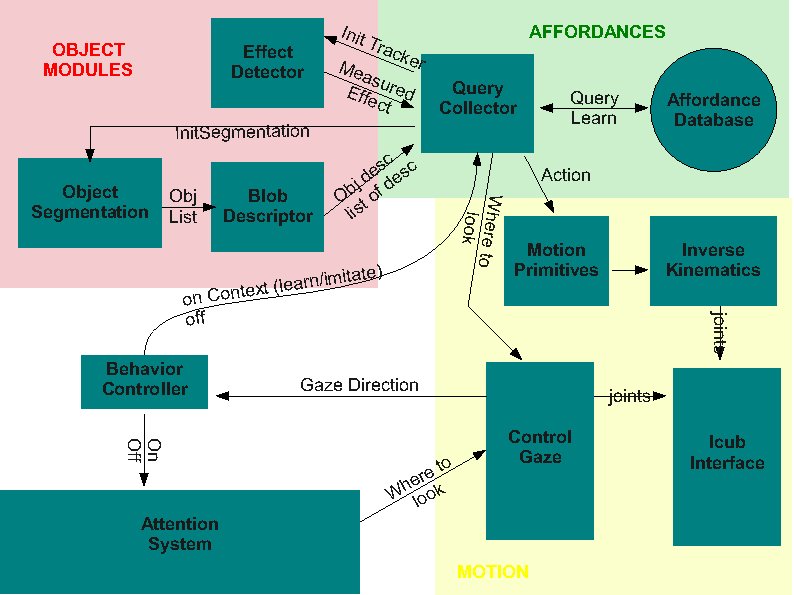Affordance imitation: Difference between revisions
(→EffectDetector: changed the default name of the image ports and removed the error port.) |
(new module: affActionPrimitives) |
||
| Line 4: | Line 4: | ||
[[Image:arch.jpg]] (updated 28/07/09) | [[Image:arch.jpg]] (updated 28/07/09) | ||
== affActionPrimitives == | |||
In November 2009, Christian, Ugo and others began the development of a library containing affordances primitives. The module is called '''affActionPrimitives''' in the iCub repository. | |||
affActionPrimitives relies on the ICartesianControl interface, hence to compile it you need to enable the module icubmod_cartesiancontrollerclient | |||
in CMake while compiling iCub repository, and to make this switch visible you have to tick the USE_ICUB_MOD just before. | |||
Attention: '''perform CMake configure/generate operations twice''' in a row prior to compiling the new module, since we discovered a CMake bug; moreover, do not remove cmake cache between the first and the second configuration. | |||
To enable the cartesian features on the PC104, as explained to Alex, you have to launch the iCubInterface pointing at the iCubInterfaceCartesian.ini | |||
file. Just afterwards you need to launch the solvers through the Application Manager XML file located under $ICUB_ROOT/app/cartesianSolver/scripts. PC104 code requires to be compiled with option icubmod_cartesiancontrollerserver active; but the iCubLisboa01 is already prepared. | |||
== BlobSegmentation == | == BlobSegmentation == | ||
Revision as of 14:19, 16 November 2009
Modules
This is the general architecture currently under development
affActionPrimitives
In November 2009, Christian, Ugo and others began the development of a library containing affordances primitives. The module is called affActionPrimitives in the iCub repository.
affActionPrimitives relies on the ICartesianControl interface, hence to compile it you need to enable the module icubmod_cartesiancontrollerclient in CMake while compiling iCub repository, and to make this switch visible you have to tick the USE_ICUB_MOD just before.
Attention: perform CMake configure/generate operations twice in a row prior to compiling the new module, since we discovered a CMake bug; moreover, do not remove cmake cache between the first and the second configuration.
To enable the cartesian features on the PC104, as explained to Alex, you have to launch the iCubInterface pointing at the iCubInterfaceCartesian.ini file. Just afterwards you need to launch the solvers through the Application Manager XML file located under $ICUB_ROOT/app/cartesianSolver/scripts. PC104 code requires to be compiled with option icubmod_cartesiancontrollerserver active; but the iCubLisboa01 is already prepared.
BlobSegmentation
Implemented by edisonSegmentation module in the iCub repository. Module that takes a raw RGB image as input and provides a segmented (labeled) image at the output, indicating possible objects or object parts present in the scene.
Ports:
- /conf
- /rawimg:i
- /rawimg:o
- /labelimg:o
- /viewimg:o
BlobDescriptor
Implemented by blobDescriptor in the iCub repository. Module that receives a labeled image and the corresponding raw image and creates descriptors for each one of the identified objects.
Ports (not counting the prefix /blobDescriptor):
/rawImg:i/labeledImg:i/rawImg:o/viewImg:o- image with overlay edges/affDescriptor:o/trackerInit:o- colour histogram and parameters that will serve to initialize a tracker, e.g., CAMSHIFT
EffectDetector
Implemented by effectDetector module in the iCub repository.
Algorithm:
1.wait for initialization signal and parameters on /init 2.read the raw image that was used for the segmentation on /rawsegmimg:i 3.read the current image on /rawcurrimg:i 4.check if the the ROI specified as an initialization parameter is similar in the two images 5.if (similarity<threshold) 6. answer 0 on /init and go back to 1. 7.else 8. answer 1 on /init 9. while(not received another signal on /init) 10. estimate the position of the tracked object 11. write the estimate on /effect:o 12. read a new image on /rawcurrimg:i 13. end 14.end
Ports:
- /init //receives a bottle with (u, v, width, height, h1, h2, ..., h16, vmin, vmax, smin), answers 1 for success or 0 for failure.
- /rawSegmImg:i //raw image that was used for the segmentation
- /rawCurrImg:i
- /effect:o //flow of (u,v) positions of the tracked object
QueryCollector
Implemented by demoAff module in the iCub repository. Module that receives inputs from the object descriptor module and the effect descriptor. When activated by the behavior controller, info about the objects is used to select actions that will be executed by the robot. In the absence of interaction activity, it notifies it to the behavior controller that may decide to switch to another behavior.
Ports:
- /demoAffv2/effect
- /demoAffv2/synccamshift
- /demoAffv2/objsdesc
- /demoAffv2/
- /demoAffv2/motioncmd
- /demoAffv2/gazecmd
- /demoAffv2/behavior:i
- /demoAffv2/behavior:o
- /demoAffv2/out
- /demoAffv2/out
Ports and communication
The interface between modules is under development. The current version (subject to changes as we refine it) is as follows:
- Behavior to AttentionSelection -> vocabs "on" / "off"
- Behavior to Query -> vocabs "on" / "off". We should add some kind of context to the on command (imitation or learning being the very basic).
- Gaze Control -> Behavior: read the current head state/position
- Query to Behavior -> "end" / "q"
- Query to Effect Detector. The main objective of this port is to start the tracker at the object of interest. We need to send at least:
- position (x,y) within the image. 2 doubles.
- size (h,w). 2 doubles.
- color histogram. TBD.
- saturation parameters (max min). 2 int.
- intensity (max min). 2 int.
- Effect Detector to Query
- Camshiftplus format
- blobDescriptor -> query
- Affordance descriptor. Same format as camshiftplus
- tracker init data. histogram (could be different from affordance) + saturation + intensity
- query -> object segmentation
- vocab message: "do seg"
- object segmentation -> blob descriptor
- labelled image
- raw image
